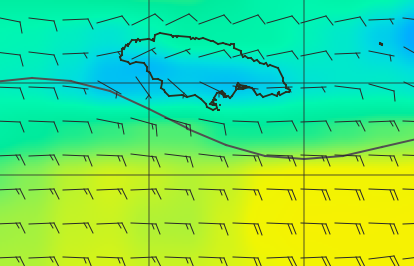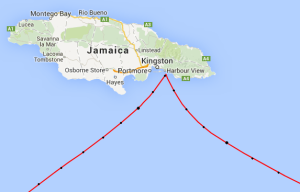
In the last chapter I’ve explained my approach to VMC-sailing, now let’s poke some holes into it. I do believe that a constant VMC target is the optimum solution for wind changing over time. That however leaves one mortal flaw: wind changes over space!
It can of course go both ways… in the Southern Ocean Dash there was a 24h stretch that saw 200 degree total windshift, 7 gybes, and infinity+1 little course adjustments. All of that could be summarized as VMC75. Yet targets can also shift quite a lot, to the point that VMC becomes meaningless. Here I will present some such cases.
Boundaries are an obvious one. When I sail to the coast, I set a target where I would ‘naturally’ tack on the beach. While tacking against the coast, one sails VMG, the target equals the TWD. My clean (no boundaries) target would point inland. Eventually my clean target will match the TWD, now I get to sail offshore again.
Grid lines are a special case (and a mechanic I don’t really like). The way gribs work allows for grid lines to have the best windspeed, in some cases, on average once per ocean race, one has to literally stick to the grid. On some polars (60ft tri) this means gybes at worse than max VMG!

Pressure gradients are a big deal. We want to stay in higher windspeeds as much as possible, so the target needs to shift in direction of the gradient. The Carib Rum Run is one of the more extreme examples, with steady TWD and TWS dropping badly near the pickups, the target shifts from west to north on the way in, and from south to west on the way out.
Grind VMG to stay in pressure longer, or if pressure fills in behind you. Speed up to move into pressure, or to reach a WP across a gradient.
Cyclones are fun. When a cyclone moves in, it’s best to set up a run at maximum boat speed. In the first leg of the Southern Ocean Dash the last 24h to Prince Edward Island were around TWA125 with little regard for windshift, just moving fast.
When following a cyclone, one ideally ends up in an equilibrum where boatspeed and direction matches the storm… in this scenario one can keep a constant TWA (near max boatspeed of course!) for possibly days.
And for the slingshot effect, there would be an optimum course in, an optimum course out, and a gybe in the center, with somewhat independent targets.
Where does all of this leave us? Above all VMC is the right tool for handling shifts. Longer races aren’t so much about shifts as finding a path across weather systems, so the target is bound to change… But I think the VMC target shows much less variation than the other key numbers (COG, TWA, TWD). I’ve never gotten around to an analytical approach, using a numerical solution. And in some situations I’ve gotten by on intuition. In the 2013 Sail Fiji, I got frustrated with BWR and hand steered the critical phase around the windhole with only the polar butterfly. Your milage may vary.
As for where one can make the biggest gains… A constant target is acceptable over a 6h wx period, unless there are steep gradients. The difference between rhumb and vanilla VMC courses is typically minutes per hour. The difference between constant and optimized floating VMC targets might be minutes per day. And gains from strategy/tactics/luck are much larger than that.
The concept of VMC does have some interesting applications when sailing against other boats, stay tuned.

I have heard about a term “WALLY” and I understand it is related to VMC sailing. Is this what you meant in your last paragraph? If not, is this technique also relevant to SOL racing and if so and if possible, would you please provide some examples?
The way I understand it, the Wally is VMC sailing adapted for real life buoy racing.